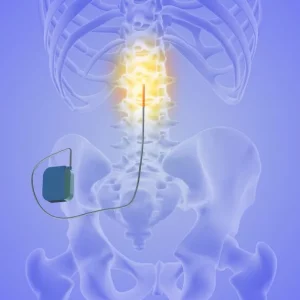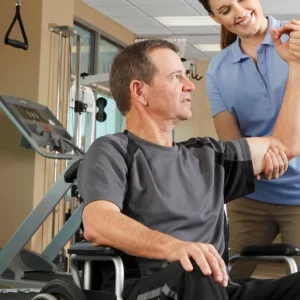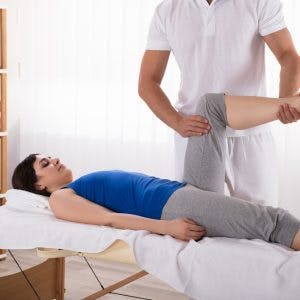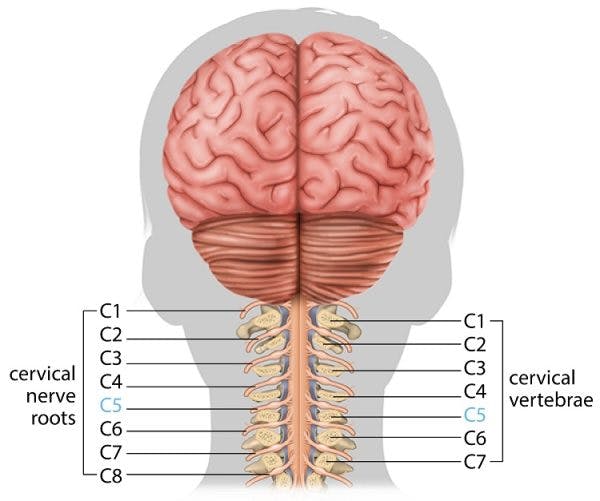Becoming paralyzed from the neck down after a spinal cord injury usually means that you’ve injured one of the higher cervical nerves. The cervical region of the spinal column has the greatest range of motion and least stability, which makes it the easiest to injure.
Paralysis of the upper and lower body is called quadriplegia. While major lifestyle adjustments will be required, many individuals learn to effectively address the outcomes of quadriplegia and improve their quality of life.
This article will go over what to expect when you’re paralyzed from the neck down and how to manage its effects.
Is Recovery Possible After Being Paralyzed From the Neck Down?
The severity of a spinal cord injury significantly affects one’s prognosis. One way to measure the severity of a spinal cord injury is to determine whether it is complete or incomplete, which your medical team will evaluate for you.
A complete spinal cord injury results in no motor control or feeling below the level of injury due to a fully transected spinal cord. This means no neural pathways between the brain and areas below the level of injury exist.
In contrast, an incomplete spinal cord injury may result in some sensation or movement below the level of injury because of spared neural pathways.
Spared neural pathways are essential for recovery after a spinal cord injury because they’re capable of utilizing neuroplasticity. Neuroplasticity is the central nervous system’s ability to adapt and reorganize its neural pathways, which means some functions affected by spinal cord injury have the potential to be relearned.
Therefore, the more spared neural pathways you have, the better the potential for recovery.
Functional abilities after an incomplete spinal cord injury can range significantly; however, as long as the injury is incomplete, spared neural pathways exist, and regaining some movement below the level of injury should be possible.
Up next, we’ll explain why an individual may become temporarily paralyzed from the neck down after a spinal cord injury, even if it’s not truly a complete injury.
Spinal Shock
Spinal shock describes the temporary loss of reflexes, motor control, and sensation below the level of injury following a spinal cord injury.
It is caused by swelling of the spinal cord, which can significantly reduce blood flow. Our bodies need blood to fuel cellular activity. Without it, the body can start to dysfunction.
As a result, many individuals mistake their incomplete spinal cord injuries for complete ones. Depending on the severity of the injury, spinal shock can last anywhere from a few days to several months. It isn’t until the swelling subsides that functions below the level of injury may begin to return.
As a result, many individuals mistake their incomplete spinal cord injuries for complete ones. Depending on the severity of the injury, spinal shock can last anywhere from a few days to several months. It isn’t until the swelling subsides that functions below the level of injury may begin to return. It’s a good idea to speak with your medical team about whether they believe you are in spinal shock or not.
Learn more about spinal shock »
Now that you understand that paralysis after a spinal cord injury is not always permanent, let’s discuss the potential outcomes of being paralyzed from the neck down.
What to Expect When Paralyzed From the Neck Down

Generally, the more severe a spinal cord injury is, the greater the risk of secondary complications.
Below, we’ll discuss some of the most common outcomes of quadriplegia.
1. Increased Dependence on Others
Individuals with severe paralysis throughout their bodies generally need the full-time assistance of a caregiver to perform activities of daily living like bathing, toileting, eating, dressing, and grooming.
While some may be able to use a power wheelchair to get around, others may need the assistance of another person.
You will likely also need your caregiver to assist you with moving from one surface to another (i.e from bed to wheelchair, etc.), or you may require the use of a mechanical lift (a device that helps to lift you and move you to another surface). Your caregiver would need to operate this device.
2. Pressure Sores
Lack of motor control and absent or impaired sensation following a spinal cord injury increases one’s risk of developing pressure sores. Pressure sores occur when individuals sit or lie in the same position for too long. Prolonged pressure can cause tissue inflammation and skin breakdown.
Generally, pressure sores develop in bony areas of the body like the elbows, hips, tailbone, sit bones, shoulder blades, knees, ankles, and heels.
To prevent the development of pressure sores, it’s essential to move the body frequently throughout the day. You should be changing positions every two hours when lying in bed, and doing “pressure reliefs” every 30 minutes when sitting up in your wheelchair.
For individuals with complete paralysis or severe weakness, they will need a caregiver to assist them with relieving this pressure multiple times a day. For those who are able to operate a power wheelchair, the tilt-back function can be used for pressure reliefs when sitting up in the chair. They even make special pressure-relieving wheelchair cushions, so be sure to talk to your therapists about this option. Even if you have one of these, position changes to relieve pressure are still necessary.
3. Inability to Regulate Body Temperature
When you’re paralyzed from the neck down, your body may struggle to regulate body temperature.
Lack of sensation following a spinal cord injury can make it difficult for your autonomic nervous system to cool down or warm up. Consequently, individuals have a greater risk of hyperthermia (overheating) and hypothermia (dangerously low body temperature).
Therefore, it is essential to be mindful of your surroundings and avoid extreme temperatures as much as possible. Similarly, individuals should be prepared to manually cool down and warm up by carrying a spray bottle, additional layers, and staying hydrated.
4. Breathing Difficulties
Higher-level spinal cord injuries can affect control over a major respiratory muscle called the diaphragm. Lack of diaphragm control can cause the inability to breathe independently.
As a result, individuals who are paralyzed from the neck down may need ventilator assistance to breathe, depending on where specifically in the cervical region their injury is.
5. Bowel, Bladder, and Sexual Dysfunction
Lack of motor control and sensation, as well as impaired reflexes following a spinal cord injury can affect bowel, bladder, and sexual functions.
For example, individuals may not be able to sense when their bladders are full, which increases the risk of leaking or urinary retention.
Similarly, individuals may not be able to control their bladder and bowel muscles and will likely need to use a catheter, suppositories medications, and/or other techniques to eliminate waste.
Your rehab doctor, occupational therapist, and nurses should be working with you consistently during your inpatient rehab stay to create a “bowel and bladder program”, in order to manage these problems. If you have little to no control in your arms, you will need help from a caregiver to perform your bowel and bladder program.
Additionally, your rehab team should also be able to provide you with information on how to cope with and manage any sexual dysfunctions, so feel free to ask questions about this if it’s on your mind.
6. Change in Body Composition
When paralyzed from the neck down, active movement is restricted. Without daily weight-bearing and movement, reductions in bone density and muscle mass occur. This can increase one’s risk of injury and slow down metabolic processes.
Having your caretaker move your body for you to perform passive range of motion exercises can help stimulate the muscles, increase range of motion, and improve circulation throughout the body.
Similarly, when you’re less physically active, the body does not expend as much energy and therefore, does not require the same caloric intake. Individuals generally need to lower their food intake after spinal cord injury to avoid excessive weight gain.
7. Spasticity
Spasticity describes involuntary muscle contractions caused by disrupted communication between the brain and body.
Because the brain can’t send signals for the muscles to relax, they become overactive and remain contracted. As a result, individuals may experience stiff movements and jerky spasms.
If poorly managed, spasticity can cause chronic pain below the level of injury and sometimes contractures, which can significantly restrict range of motion.
8. Autonomic Dysreflexia
Autonomic dysreflexia is a condition that can occur following a T6 or higher level spinal cord injury. It’s primarily characterized by a sudden spike in blood pressure when areas below the level of injury are stimulated. Common causes of autonomic dysreflexia include wearing tight clothes or jewelry, a full bladder or bowels, extreme temperatures, or irritation to the skin.
Because messages from the brain are unable to get past the SCI, the body cannot relax.
Other symptoms of autonomic dysreflexia include:
- Feelings of panic
- Increased sweating
- Flushed skin
- Chest tightness
- Headaches
If you experience any of these symptoms, it’s essential to identify what is triggering autonomic dysreflexia and remove it immediately. Symptoms should consequently subside. If they don’t, seek immediate medical attention
Now that you understand potential complications that can occur when you’re paralyzed from the neck down, let’s discuss treatment.
Recovering From Quadriplegia
Depending on the severity of your injury, you may be able to recover movement. Because every spinal cord injury is unique, a personalized rehabilitation plan that targets your specific weaknesses is essential.
Rehabilitative interventions for spinal cord injury patients include:
- Physical therapy focuses on maximizing mobility through targeted exercise. If functions below your level of injury are spared, PT can help strengthen those movement patterns.
- Occupational therapy teaches you new ways to perform activities of daily living like grooming, dressing, and toileting to help you become as functional as possible.
- Speech therapy may be necessary for you early on in your recovery if you are ventilator-dependent or have any breathing issues due to your diaphragm being affected. This type of therapy can help you to improve breath support, and can also help you to manage your oral secretions, an ability that is sometimes impaired after a high-level SCI.
- Psychotherapy can help you cope with the emotional and psychological outcomes of SCI. A psychotherapist can provide helpful insight and resources to help you adjust.
- Orthotics provide structural support to help you sit upright and mildly stretch spastic muscles.
- Medications can help you manage various secondary complications of SCI such as pain, incontinence, and depression.
Because individuals who are paralyzed from the neck down generally require full-time caregiver assistance, rehabilitation often involves learning how to work with your caregiver.
Living with Paralysis From the Neck Down
Paralysis from the neck down occurs following higher-level cervical spinal cord injuries. While loss of motor control and sensation throughout the body will require major lifestyle changes, rehabilitative interventions can help you learn to adjust and maximize your independence.
We hope this article helped you understand what to expect when you’re paralyzed from the neck down and how to manage its effects.
Photo credits: iStock/Halfpoint










